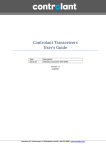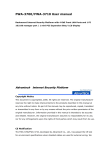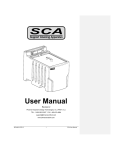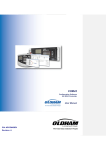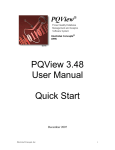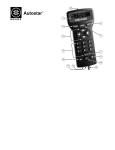Download Banks PowerPDA® Software & Installation Kit
Transcript
Banks PowerPDA® Software & Installation Kit (For use with OttoMind®6 tuners) For use with Palm® Tungsten™ E2 only 2001-2005 Chevy Duramax 2003-2006 Dodge Cummins 2003-2006 Ford Power Stroke THIS MANUAL IS FOR USE WITH KITS 61100, 61102, 61104, 61106, 61108, 61110, 61112 Gale Banks Engineering 546 Duggan Avenue • Azusa, CA 91702 (626) 969-9600 • Fax (626) 334 -1743 Product Information & Sales: (800) 438-7693 Customer Support: (888) 839-5600 Installation Support: (888) 839-2700 bankspower.com ©2007 Gale Banks Engineering 05/22/07 PN 96803 v.3.0 2 96803 v.3.0 Table of Contents Introduction. . . . . . . . . . . . . . . . . . . . 4 Section 1 . . . . . . . . . . . . . . . . . . . . . . 5 Charging the PDA Section 2 . . . . . . . . . . . . . . . . . . . . . . 6 Installing the Banks PowerPDA Software Section 3 . . . . . . . . . . . . . . . . . . . . . . 8 Mounting the Docking Station and Connecting the Banks PowerPDA Section 4 . . . . . . . . . . . . . . . . . . . . . 20 Software Introduction Section 5 . . . . . . . . . . . . . . . . . . . . . 20 Changing Power Levels Section 6 . . . . . . . . . . . . . . . . . . . . . 21 System Menu Section 7 . . . . . . . . . . . . . . . . . . . . . 22 Sleep Mode and Power Save Setting Section 8 . . . . . . . . . . . . . . . . . . . . . 24 System Monitors Section 9 . . . . . . . . . . . . . . . . . . . . . 26 Gauge Set-Up Section 10 . . . . . . . . . . . . . . . . . . . . 27 On Screen Alerts Section 11 . . . . . . . . . . . . . . . . . . . . 29 Checking and Clearing OBD II Diagnostic Codes Section 12 . . . . . . . . . . . . . . . . . . . . 30 Performance Testing Section 13 . . . . . . . . . . . . . . . . . . . . 32 Self Diagnostics Section 14 . . . . . . . . . . . . . . . . . . . . 33 Recalibration for Non-Stock Tire Sizes (and Non-Stock Gear Ratios) Section 15 . . . . . . . . . . . . . . . . . . . . 35 Exiting the Banks PowerPDA Application Section 16 . . . . . . . . . . . . . . . . . . . . 36 Troubleshooting 96803 v.3.0 3 Introduction boost and EGT values. Performance runs are automatically stored for later retrieval with a time-and-date stamp. With The Banks PowerPDA, you can also scan and clear OBD II diagnostic codes. It gives you the endless functionality of a Palm® Tungsten™ E2 PDA, and fits in a custom docking station using infrared wireless connectivity. The Banks PowerPDA is a versatile touch-screen interface to the OttoMind®6 tuner and your truck. With the push of a button, you can change power levels on-the-fly. It displays four engine functions at a time, two of which are user-selectable (over a dozen to choose from). It will clock your 0-60 mph, 1⁄ 8-mile and 1⁄ 4-mile performance runs, recording peak Figure 1 Front view HOME KEY 5-WAY NAVIGATOR MENU KEY CENTER BUTTON 4 96803 v.3.0 (UP) (DOWN) Section 1 CHARGING THE PDA The Palm Tungsten E2 will need to be charged for a minimum of one hour before the unit will function. The Palm Tungsten E2 can be charged either by the supplied AC-outlet wall charger or by the integrated charging cable in the Docking Station. The unit will be fully charged in one to two hours. After a minimum charge of one hour, press the power button to turn on the Banks PowerPDA. (See Figure 1 and 2) Follow the on-screen instructions to set-up the Palm Tungsten E2 The Palm Tungsten E2 will ask for time, date, time zone and require that you perform an on-screen stylus accuracy test. (See Figure 3 and 4). Once initial setup is complete the Palm Tungsten E2 will be ready for the Banks PowerPDA software installation. -END, SECTION 1- Figure 2 Top view EXPANSION SLOT Figure 3 POWER BUTTON Figure 4 96803 v.3.0 5 Section 2 INSTALLING THE BANKS POWERPDA SOFTWARE The Banks PowerPDA software is supplied on a Secure Digital (SD) media card. The software should be installed on the Palm Tungsten E2 and run from main memory. You can use the additional space on the SD card to store music, photos and other data. Refer to your device instruction manual for using SD cards to store data. You should leave a copy of the Banks PowerPDA software on the SD card as a backup for future reference. 1. Insert the SD card into the slot on Figure 5 Figure 7 Figure 6 Figure 8 6 96803 v.3.0 the top of the Palm Tungsten E2. Note: the contents of the SD card should appear on the screen. (The “Banks” Icon). (See Figure 1) 2. Select the ‘Menu’ button on the bottom of the Palm Tungsten E2 (beneath the ‘Home’ key). Then select ‘Copy’. (See Figure 5) 3. In the ‘Copy From’ drop down Figure 9 menu select “Card”. (See Figure 6) The ‘Copy To’ selection will automatically change to “Device”. (See Figure 7) select on the “Banks” icon, if it is not selected or there is more than one item in the list. Touch the “Copy” button. (See Figure 8) A dialog box will appear, indicating the Palm Tungsten E2 is copying the software from the SD card. Once completed, press the “Done” button. 4. Select the drop-down menu in the upper right hand corner of the screen. Touch the button labeled ‘All’. The Banks PowerPDA software is now installed. You may now remove the SD Card from its slot. 5. To start the Banks PowerPDA software touch the icon called “Banks”. (See Figure 9) -END, SECTION 2- 96803 v.3.0 7 Section 3 MOUNTING THE DOCKING STATION AND CONNECTING THE BANKS POWERPDA Note: This system has been designed for use with the Palm Tungsten E2 PDA. 3. After test fitting, remove the liner Warning: The PDA may be susceptible to damage as a result of extended exposure to sunlight, heat or extreme cold. It is highly recommended that the PDA be removed from its mounting location if the vehicle will be subjected to high concentrations of sunlight, heat or cold for an extended period of time. Gale Banks Engineering is not responsible for damage to PDAs resulting from exposure conditions. 4. Carefully align and secure the Locate the Docking Station in your kit. The mounting location of the Docking Station is vehicle specific. It is not a universal fit. Make sure to do a dry prefit before permanently mounting. For mounting locations, refer to the following figures: from the adhesive tape on the back of the Docking Station. Docking Station to the dash in the same location as it was test fit. Press the Docking Station firmly against the dash for one minute to ensure good adhesion. Vehicle specific instructions follow. For For For For Chevy/GMC, proceed to step 5. Dodge, proceed to step 15. Ford (’03-’04) proceed to step 15. Ford (’05), proceed to step 34. Chevy/GMC 5. Locate the two self-drilling screws supplied in your kit. 6. Install the screws through the Figure 15 – Dodge two access holes in the right side of the Docking Station. Doing this will put two permanent holes in the dashboard panel. Be certain of the location of the Docking Station before installing the screws. Figure 22 – Ford (’03-’04) 7. Two push-in plastic plugs are Figure 11 – Chevy/GMC Figure 25 – Ford (’05-’06) Note: In cold climates, best results will be obtained if the vehicle’s heater is run to bring the inside temperature up to “room temperature” (at least 68°F). 1. Clean mounting area with isopropyl alcohol or similar residue-free cleaning agent to prepare the surface for the adhesive tape. 2. The Docking Station has adhesive tape applied to it at the factory. Prior to removing the protective liner from the tape, test fit the unit on the dash as indicated in the appropriate photo. Refer to the figure list above for vehicle-specific mounting locations. The Docking Station will fit the dash contours only where shown in the photos. 8 96803 v.3.0 provided to cover the two screw access holes in the Docking Station. Install the plugs at this time. Note: The Docking Station must be connected to the previously installed Banks PowerPDA-compatible OttoMind6 tuner via the OBD II interface cable. If your OttoMind6 tuner is not installed, refer to the OttoMind6 tuner owner’s manual to install the tuner before proceeding. 8. Locate the Banks OBD II Interface Cable in your kit. This cable has three connection points. Connect the red OBD II connector on the Banks interface cable to the vehicle OBD II connector. Use a cable tie as shown in Figure 10 to secure the Banks interface cable to the vehicle OBD II connector. Next, connect the Figure 10 Chevy/GMC Figure 11 Chevy/GMC 96803 v.3.0 9 Figure 12 Chevy/GMC 6-pin connector on the Banks OBD II interface cable to the 6-pin connector on the OttoMind6 Tuner harness. 9. Finally, unclip the dashboard panel, starting with the lower right hand corner. (See Figures 11-14) Pry and unclip as needed to gain enough clearance to route the RJ12 cable (simular to telephone connector) behind the panel, along its lower edge. 10. Locate the RJ12 connector portion on the Banks interface cable and pull enough cable through to reach the bottom of the Docking Station. 11. Connect the RJ12 cable into the left-most receptacle on the bottom of the Docking Station. Warning: The charging cable on the Docking Station is designed to supply a constant low-voltage power source (+5VDC) to the Banks PowerPDA and is “live” as long as the system’s OBD II interface cable is completely installed and the RJ12 connector is plugged into the Docking Station. Although 10 96803 v.3.0 this charging cable is short and its circuitry is fuse-protected, the user is expected to take appropriate measures to prevent small children and/or pets from contact with any part of this system. 12. Refit the dash panel by carefully snapping it back into place. Tuck any excess cable behind it for a clean appearance. 13. Your Docking Station is now installed and is ready for the Banks PowerPDA. Install the Banks PowerPDA into the Docking Station. Be sure the Banks PowerPDA is completely seated in the Docking Station against the lower support bracket. 14. Plug the Docking Station’s charging cable into the charging receptacle on the lower edge of the Banks PowerPDA. NOTE: There may be a snug fit when installing the Banks PowerPDA into the Docking Station. Take care not to force this process. Figure 13 Chevy/GMC Figure 14 Chevy/GMC 96803 v.3.0 11 Dodge Note: The Docking Station must be connected to the previously installed Banks PowerPDA-compatible OttoMind6 tuner via an RJ12 cable (simular to telephone connector). If your OttoMind6 tuner is not installed, refer to the OttoMind6 tuner owner’s manual to install the tuner before proceeding. 15. To route the RJ12 cable connecting the Docking Station to the OttoMind6 (see OttoMind6 owners manual for details), you will need to unclip the knee panel (See Figure 16) Pry and unclip as needed to gain enough clearance to route the cable behind the panel. 16. Locate the RJ12 cable on your OttoMind6 wiring harness and pull enough cable through to reach the bottom of the Docking Station. 17. Locate and remove the screw in the dash panel above the hook as shown in Figure 17. 18. Remove the dash panel by gently pulling and unclipping it as needed. (See Figure 18). Figure 15 Dodge 12 96803 v.3.0 19. Guide the RJ12 cable through the clearance between the removed panel and the dash as shown in Figure 19. 20. Looking at the back of the dash panel, locate the screw for the dash plate as shown in Figure 20. This panel may be blank, or contain the airbag deactivation switch. Remove the screw and the plate. 21. Route the RJ12 cable through the opening and connect it to the left most receptacle on the bottom of the Docking Station. Replace the dash plate and screw. Warning: The charging cable on the Docking Station is designed to supply a constant low-voltage power source (+5VDC) to the Banks PowerPDA and is “live” as long as the system’s OBD II interface cable is completely installed and the RJ12 connector is plugged into the Docking Station. Although this charging cable is short and its circuitry is fuse-protected, the user is expected to take appropriate measures to prevent small children and/or pets from contact with any part of this system. Figure 16 Dodge Figure 17 Dodge 96803 v.3.0 13 22. Refit the dash panel and knee panel by carefully snapping them back into place. Tuck any excess cable behind it for a clean appearance. (See Figure 21) 23. Your Docking Station is now installed and is ready for the Banks PowerPDA. Install the Banks PowerPDA into the Docking Station. Be sure the Banks PowerPDA is completely seated in the Docking Figure 18 Dodge Figure 19 Dodge 14 96803 v.3.0 Station against the lower support bracket. 24. Plug the Docking Station’s charging cable into the charging receptacle on the lower edge of the Banks PowerPDA. NOTE: There may be a snug fit when installing the Banks PowerPDA into the Docking Station. Take care not to force this process. Figure 20 Dodge Figure 21 Dodge 96803 v.3.0 15 Ford (’03-04) 25. Locate the self-drilling screw supplied in your kit. 26. Install the screw through the large access hole in the bottom of the Docking Station. Doing this will put a permanent hole in the dashboard panel. Be certain of the location of the Docking Station before installing the screw. Note: The Docking Station must be connected to the previously installed Banks PowerPDAcompatible OttoMind6 tuner via an RJ12 cable (simular to telephone connector). If your OttoMind6 tuner is not installed, refer to the OttoMind6 tuner owner’s manual to install the tuner before proceeding. 27. Remove the fuse access panel below the steering column. It is secured by four 1⁄ 4-turn plastic screws. 28. Remove the smaller dash panel immediately to the right as shown in Figures 23 and 24. Unclip it by pulling in the area shown in the picture. 29. Locate the RJ12 cable from your OttoMind6 Wiring harness and route it to the bottom of the Docking Figure 22 Ford (’03-’04) 16 96803 v.3.0 Station behind the panels you’ve just removed. 30. Connect the RJ12 cable to the left-most receptacle on the bottom of the Docking Station. Warning: The charging cable on the Docking Station is designed to supply a constant low-voltage power source (+5VDC) to the Banks PowerPDA and is “live” as long as the system’s OBD II interface cable is completely installed and the RJ12 connector is plugged into the Docking Station. Although this charging cable is short and its circuitry is fuse-protected, the user is expected to take appropriate measures to prevent small children and/or pets from contact with any part of this system. 31. Refit the dash panel by carefully snapping it back into place. Refit the fuse access panel using the four fasteners removed earlier. Tuck any excess cable behind the panels for a clean appearance. 32. Your Docking Station is now installed and is ready for the Banks PowerPDA. Install the Banks PowerPDA into the Docking Station. Be sure the Banks PowerPDA is completely seated in the Docking Station against the lower support bracket. 33. Plug the Docking Station’s charging cable into the charging receptacle on the lower edge of the Banks PowerPDA. NOTE: There may be a snug fit when installing the Banks PowerPDA into the Docking Station. Take care not to force this process. Figure 23 Ford (’03-’04) Figure 24 Ford (’03-’04) 96803 v.3.0 17 Ford (’05-’06) Note: The Docking Station must be connected to the previously installed Banks PowerPDA-compatible OttoMind6 tuner via an RJ12 cable. If your OttoMind6 tuner is not installed, refer to the OttoMind6 tuner owner’s manual to install the tuner before proceeding. 38. Your Docking Station is now installed and is ready for the Banks PowerPDA. Install the Banks PowerPDA into the Docking Station. Be sure the Banks PowerPDA is completely seated in the Docking Station against the lower support bracket. 34. Remove the fuse access panel 40. Plug the Docking Station’s charging cable into the charging receptacle on the lower edge of the Banks PowerPDA. 35. Remove the smaller dash panel NOTE: There may be a snug fit when installing the Banks PowerPDA into the Docking Station. Take care not to force this process. below the steering column by pulling on it with the handles as shown in Figure 26. immediately to the right as shown in Figure 27. Unclip it by pulling in the area shown in the picture. 36. Locate the RJ12 cable from your OttoMind6 Wiring harness and route it to the bottom of the Docking Station behind the panels you’ve just removed. 37. Connect the RJ12cable to the leftmost receptacle on the bottom of the Docking Station. Warning: The charging cable on the Docking Station is designed to supply a constant low-voltage power source (+5VDC) to the Banks PowerPDA and is “live” as long as the system’s OBD II interface cable is completely installed and the RJ12 connector is plugged into the Docking Station. Although this charging cable is short and its circuitry is fuse-protected, the user is expected to take appropriate measures to prevent small children and/or pets from contact with any part of this system. 38. Refit the dash panel by carefully snapping it back into place. Refit the fuse access panel and tuck any excess cable behind the panels for a clean appearance. 18 96803 v.3.0 -END, SECTION 3Figure 25 Ford (’05-’06) Figure 26 Ford (’05-’06) Figure 27 Ford (’05-’06) 96803 v.3.0 19 Section 4 SOFTWARE INTRODUCTION With the key in the ‘ON’ position, turn the Banks PowerPDA on and click on the “Banks” icon. (See Figure 28) The Banks PowerPDA software will initialize and the System Monitor screen will appear. (See Figure 29) The default System Monitor screen Figure 28 shows the following: four Gauges, Power Level, OttoMind6 Tuner Status, Hist-O-Graph and a status window. The System Monitor is the Banks PowerPDA’s main screen. -END, SECTION 4Figure 29 Section 5 CHANGING POWER LEVELS To change between power levels use the 5-way navigator button. (See Figure 1) 1. Press the navigator button up to increase the displayed power level. 2. Press the navigator button down to decrease the displayed power level. 20 96803 v.3.0 Note: The selectable power levels are 1 thru 6. Level 1 produces stock power and level 6 produces the maximum power. The selection of a power level can be done with the vehicle on, off (when the Banks PowerPDA is on), or while driving. -END, SECTION 5- Section 6 SYSTEM MENU 1. Press the center button on the 5- way navigator to move to the System Menu. The two System Menu screens have ten labeled touch screen buttons. (See Figure 30 and 31). 2. To navigate between screens, touch the ‘More>’ or ‘<Back’ buttons. Further discussion of each field will be covered later in the manual. Refer to Section 9 for additional information. -END, SECTION 6Figure 30 Figure 31 96803 v.3.0 21 Section 7 SLEEP MODE AND POWER SAVE SETTING ‘Sleep Mode’ is a non-adjustable feature that is part of the Banks PowerPDA application. The Banks PowerPDA is designed, when in the System Monitor screen, to initiate ‘Sleep Mode’ when the vehicle is turned off or when communication is lost. After communication is lost or the ignition is switched off the Banks PowerPDA will go into ‘Sleep Mode’ in approximately 10 seconds. When in ‘Sleep Mode’ there will be a dimly lit ‘Banks’ screensaver in the background. (See Figure 32) The Banks PowerPDA will wake from ‘Sleep Mode’ when the ignition is switched on or the Banks PowerPDA regains communication. To manually wake the Banks PowerPDA from Sleep Mode, press the center button on the 5-way navigator. Figure 33 Figure 34 The Tungsten E2 also has a user selectable ‘power save‘ feature that can be programmed by the user. Note: The System Monitor screen ‘Sleep Mode’ is not affected by the Tungsten E2 ‘power save’ settings. Figure 32 1. From the Tungsten E2 Home Screen (‘Home’ key), scroll down and locate the ‘Prefs’ icon. 2. Touch the ‘Prefs’ icon. (See Figure 33). 3. Touch the button labeled ‘Power’ to enter the edit page. (See Figure 34). 4. Touch the button labeled ‘Auto-off after’. (See Figure 35) 22 96803 v.3.0 5. Select from the following: 30 seconds, 1 minute, 2 minutes, and 3 minutes. This setting sets the Power Save time limit. (See Figure 36) 6. Touch the button labeled ‘On while Charging:’, then select either ‘ON’, or ‘OFF’. If you select the ‘ON’ setting the Banks PowerPDA will remain ‘ON’ indefinitely when in the Docking Station (with it’s charging cable plugged-in) and NOT in the System Monitor screen. NOTE: The Banks PowerPDA will stay ON regardless if Figure 35 communication is lost or the ignition is switched off, if not in the System Monitor screen. If the ‘OFF’ setting is selected the Banks PowerPDA will auto shut-off at the previously selected time interval when NOT in the System Monitor screen. NOTE: The Banks PowerPDA will not auto shut-off if in the System Monitor screen unless the vehicle is turned off or if communication is lost for more than 10 seconds. -END, SECTION 7- Figure 36 96803 v.3.0 23 Section 8 SYSTEM MONITORS The default System Monitor screen displays the following: Gauges G1, G2, G3, G4, Power level, Status Indicator, Hist-O-Graph and a Status Window. (See Figure 37). The top two gauge displays (G1 and G2) are EGT and BOOST, which cannot be changed. The bottom two gauges (G3 and G4) can be changed to display the available ‘Parameters’. Refer to section 10 for instructions on changing the G3 and G4 gauge displays. The selectable power levels are 1 thru 6. (Refer to Section 5-Changing Power Levels). Below the Power Level Indicator is the Status Indicator. When communications are established between the Banks PowerPDA , OttoMind6 Tuner and vehicle PCM then an ’OK’ will be displayed. In the event that an on-screen alert or OttoMind6 malfunction is triggered, the indicator will show an icon relative to the alert. The lower half of the screen displays a Hist-O-Graph, which displays a continuous graph of EGT and boost readings. ‘Hist-O-Graph’ is the name of the default System Monitor screen. 1. To change the ‘System Monitor’ Figure 37 GAUGE G1 GAUGE G2 GAUGE G3 POWER LEVEL INDICATOR STATUS INDICATOR GAUGE G4 HIST-O-GRAPH EGT(˚F) 24 96803 v.3.0 BOOST(PSI) STATUS WINDOW screen press the center button on the 5-way navigator. This will take you to the System Menu screen. 2. Touch the ‘System Monitor’ button. 3. On the ‘Choose System Monitor’ screen, there will be three choices for display (See Figure 38). Choose between the Hist-O-Graph (default) (See Figure 39), Vertical Bar Graph (See Figure 40 and the Horizontal Bar Graph. (See Figure 41). The bottom of the page displays the Current Monitor Figure 38 Figure 39 Hist-O-Graph ‘Status’ and the ‘<Back’ button. The ‘<Back’ button takes you to the previously viewed screen. Select the button corresponding to the System Monitor screen that you choose to be the active screen. Check the ‘Status’ line to verify the correct screen is selected. 4. Touch the ‘<Back’ button twice to return to the System Monitor screen. -END, SECTION 8Figure 40 Verticle Bar Figure 41 Horizontal Graph 96803 v.3.0 25 Section 9 GAUGE SET-UP Note: There are multiple selectable parameters to choose from. Specific parameters vary with vehicle applica tion 6 Press the ‘Back’ button twice to return to the System Monitor screen. The System Monitor screen will now display your new G3 and G4 parameters. 1. Press the center button on the -END, SECTION 9- 5-way navigator to take you to the System Menu screen. 2. Next, touch the ‘Gauge Setup’ button. (See Figure 30) 3. The current gauge display will be shown in G3 and G4 (See Figure 42). To change the displayed parameter, scroll through and select from the available parameters. 4. Use the buttons labeled ‘Up’ and ‘Down’ to scroll through the list. 5. To select the desired parameter, highlight it by touching on the parameter then touch on either the G3 or G4 gauge button. The respective gauge display will change accordingly. 26 96803 v.3.0 Figure 42 Section 10 ON SCREEN ALERTS The ‘On Screen Alert’ menu allows you to configure the volume control for alarms and the corresponding parameter to be monitored. The available alerts icons can be seen in Figure 43. NOTE: In the event an alert set point is reached an audible alarm will sound off and the Status Indicator will display an icon relative to the associated alert. (See Figure 46). The alarm will turn off once the associated parameter is below its alert set-point. The Status Indicator will then return to ‘OK’. value at which the alert will occur based on exhaust gas temperature. The selection range is 1100˚ to 1700˚. The default value is 1450˚. Note: This is an alert only. The OttoMind6 is calibrated to begin defueling when 1350˚ is reached, regardless of the Alert Setting. Screen 1 of the ‘On Screen Alerts’ menu edits the ‘Exhaust Gas Temperature Alert Set Point’. 5. Touch the ‘Increase’ button to increase the temperature set point. 1. Press the center button on the 6. Touch the ‘Decrease’ button to 2. Next, touch the ‘On Screen Alerts’ 7. Touch the ‘Save’ button to save the 3. On the ‘Set Volume for Alerts’ 8. Touch the ‘Next’ button to edit 4. Touch the ‘Next’ button to move to the ‘On Screen Alerts’ screen. (Figure 45). 9. Touch the ‘Done’ button to return This selection allows you to set the 10. Touch the ‘Back’ button to return 5-way navigator to take you to the System Menu screen. button. screen, touch the desired sound level to set the alarm level. (See Figure 44) Figure 43 decrease the temperature set point. The increments are set at 25 degrees. setting. the next parameter. Follow the same procedure listed above for the remaining alerts. to the System Menu. to the ‘System Monitor’ screen. -END, SECTION 10Figure 44 EXHAUST GAS TEMP ENGINE COOLANT TEMP ENGINE OIL TEMP TRANSMISSION TEMP OTTOMIND6 TUNER FAULT 96803 v.3.0 27 Figure 45 28 96803 v.3.0 Figure 46 Section 11 CHECKING AND CLEARING OBD II DIAGNOSTIC CODES Checking for OBD II Diagnostic Codes 1. Press the center button on the 5-way navigator to take you the the System Menu screen. 2. Next, touch the ‘OBD II’ button. 3. With the ignition in the on/run position or with the engine running, touch the button labeled ‘Check For Codes’. (See Figure 47). Note: The Banks PowerPDA will check for vehicle diagnostic codes and display either the p-code with a brief description of the code or the message “Done! – No Codes Present”. For a full description of the code, highlight the code and a window will pop up with a detailed explanation. be running. If the engine is running, Banks PowerPDA will display a pop-up message instructing you to check the ignition key is in the ON position. 6. Press’Check For Codes’ again to verify the OBD II codes were erased. Some status monitor codes require a certain amount of engine “run time” in order to be cleared (i.e. P1000 on Ford). 7. If diagnostic codes reoccur on your vehicle, you should investigate the underlying problem to correct it. -END, SECTION 11Figure 47 4. To return to the System Menu touch ‘<Back’. If diagnostics were found and you would like to clear them, proceed to step 5. Clearing OBD II Diagnostic Codes 5. After checking for and reviewing any diagnostic codes, touch ‘Clear Codes’ to erase them from the vehicle ECU. If multiple codes are present, they will all be cleared. NOTE: On Dodge vehicles, the ignition key must be in the On/Run position, but the engine must NOT 96803 v.3.0 29 Section 12 PERFORMANCE TESTING Note: For the Banks PowerPDA to do performance testing, Gauge G3 or G4 must be set to monitor MPH. Refer to section 10 to change Gauge G3 or G4 to read MPH. If a performance test is selected without either gauge G3 or G4 displaying MPH, a pop-up window will appear. 2. Next, touch the ‘Perf. Tests’ button. 3. Select the desired performance test by touching the appropriate button. The three tests to choose from are: mile ET, 1⁄ 4 mile ET, and 0-60 MPH Test. (See Figure 48) 1⁄ 8 For any of the performance tests to be accurate, the vehicle must not be moving at the start of the test. The recommended method of setting up a ‘Performance Test’ is as follows: Note: After selecting the desired test, the Banks PowerPDA will immediately arm itself and wait for vehicle motion to begin recording. To ensure accuracy, the vehicle should be completely stopped when selecting the test. a. Engine on, Banks PowerPDA on, transmission gear in park. Figure 49 b. Foot firmly on brake, select drive gear. c. Select the desired ‘Performance Test’. d. Banks PowerPDA is armed and ready for testing . e. Test begins once vehicle motion is detected. Setting up for Performance Testing 1. Press the center button on the 5-way navigator to take you the the System Menu screen. Figure 48 30 96803 v.3.0 Figure 50 After choosing the desired Performance Test the Banks PowerPDA will acknowledge by displaying “Performance Test Armed” in the Status Window on the System Monitor screen. (See Figure 49) Banks PowerPDA will begin the Performance Test once it detects motion of the vehicle. The Banks PowerPDA will monitor the elapsed event until the pre-selected distance or speed is reached. Upon completion of the selected Perfomance Test, the Figure 51 Banks PowerPDA will automatically display a “results” screen, which includes elapsed time/distance parameters along with a graph of EGT/Boost/MPH for the run. Each completed Performance Test will be saved for future analysis. Viewing Saved Performance Tests 4. To view a previously completed Performance Test touch the button labeled ‘Recall Saved’. (See Figure 48) 5. Use the Up and Down buttons to select the Performance Test you want to review. (See Figure 50) 6. Touch the button labeled ‘Open’, to view in detail the results of the saved Performance Test. Use the’ <PREV’ and ‘NEXT>’ buttons to move the curser one frame at a time in the displayed graph area. Moving between the frames will automatically update the displayed parameter values. (See Figure 51) 7. Press ‘Done’ when finished. 8. For further information touch the button labeled ‘Help’ on the Performance Tests screen. Figure 52 9. Touch the button labeled ‘Back’ to return to the System Monitor screen. Deleting Saved Performance Tests 10. To delete a previously saved Performance Test, highlight the saved test you wish to delete and touch the button labeled ‘Delete’. 11. A pop up window labeled ‘Confirm Delete’ will ask you to confirm the deletion of the test.. (See Figure 52) 12. Touch the button labeled ‘Yes’ to confirm or ‘No’ to decline. -END, SECTION 12- 96803 v.3.0 31 Section 13 SELF DIAGNOSTICS 1. Press the center button on the 5-way navigator to take you the the System Menu screen. 2. Touch the button labeled ‘More>’ to move to the second screen of the System Menu. 3. Next, touch the ‘Self Diagnostics’ button. (See Figure 53) 4. The ‘Self Diagnostics’ screen displays a log of diagnostic events related to the OttoMind6 tuner (See Figure 54). the list is updated, the most current event will appear at the top of the list. Each event has on associated timestamp and description, which will be displayed below the list when that event is highlighted. Each key cycle of the vehicle produces a minimum of two logged events. 5. Touch the button labeled ‘Down’ to scroll down through the recorded events. 6. Touch the button labeled ‘Up’ to scroll up through the recorded events. The ‘Logged Events’ list takes a moment to update each time this screen is opened (as indicated by a slight flickering of the list). Once 7. Touch the ‘Back’ button to return to Figure 53 Figure 54 32 96803 v.3.0 the System Monitor screen. -END, SECTION 13- Section 14 RECALIBRATION FOR NON-STOCK TIRE SIZES (AND NON-STOCK GEAR RATIOS) Note: The Banks PowerPDA is capable of displaying a corrected speed on the System Monitor. This will improve the accuracy of performance tests if you have non-stock tires sizes or gear ratios. The Banks PowerPDA does not reprogram your vehicle’s ECM to correct the speedometer. 1. Press the center button on the 5-way navigator to take you the the System Menu screen. 2. Touch the button labeled ‘More>’ to move to the second screen of the System Menu. 3. Next, touch the ‘Recal. Tire Size’ button. (Figure 53) Note: In order for the Banks PowerPDA to perform the recalibration procedure, Gauge G3 or G4 must be set to monitor MPH. Refer to section 10 to change Gauge G3 or G4 to read MPH. 4. The Banks PowerPDA can display a corrected vehicle speed for vehicles that have non-stock tires or gear ratios. This procedure only needs to be performed once unless you delete and reinstall the Banks PowerPDA software or change tire size or gear ratios after calibration. Note: To reset the scaling to its original setting, perform this procedure with the vehicle stopped. (MPH=0) speeds match exactly, you will press the ‘CENTER’ button on the 5-way navigator. The Banks PowerPDA will then calculate the proper tire scaling factor. Touch the button labeled ‘Next>’. (Figure 56) 6. What speed will the ‘pace’ vehicle drive during recalibration? Touch the button labeled 45 MPH, 55 MPH, or 65MPH. The selected button will display parenthesis around its text to denote active status. (See Figure 57) NOTE: The pace vehicle should drive the speed you choose. Ignore what your speedometer or what the Banks PowerPDA displays for MPH during this process. 7. Touch ‘Start Recal’. The Banks PowerPDA will return to the System Monitor and wait for your input to calculate the scaling factor. 8. Accelerate the vehicle until your speed matches the pace vehicle’s speed as closely as possible. Ignore the speed indicated by the Banks PowerPDA and your speedometer. Figure 55 Touch the button labeled ‘Next>’. (Figure 55) Note: To calibrate your speedometer using a pace vehicle, proceed to step 5. To use a GPS device, proceed to step 10. Pace Vehicle Method 5. This procedure requires the assistance of another vehicle that will drive next to your vehicle at a specific speed. You will drive the same speed as the ‘pace’ vehicle. Once your 96803 v.3.0 33 9. Once your speeds match, press the speed in MPH (see your device owner’s manual). GPS Method 12. To select the speed you want to drive when calibrating your speedometer, touch the button labeled 45 MPH, 55 MPH, or 65 MPH. The selected button will display parenthesis around its text to denote active status. The speed chosen will not affect the accuracy of the results. center button on the 5-way navigator. The Banks PowerPDA will instantly calculate the scaling factor for your vehicle speed signal. (See Figure 58) 10. Use of a GPS device to calibrate your speedometer will give the most accurate results and does not require the use of an additional vehicle. 11. Set your GPS receiver to display Figure 56 13. Touch ‘Start Recal’. The Banks PowerPDA will return to the System Monitor and wait for your input to calculate the scaling factor. 14. Accelerate the vehicle until the GPS indicates that you are traveling at the speed chosen in the previous step. Ignore the speed indicated by the Banks PowerPDA and your speedometer. 15. Once you have reached the predetermined speed, press the center button on the 5-way navigator. The Banks PowerPDA will instantly calculate the scaling factor for your vehicle speed signal. (See Figure 58) -END, SECTION 14- 1. To exit the Banks PowerPDA Figure 57 34 96803 v.3.0 Figure 58 Section 15 EXITING THE BANKS POWERPDA APPLICATION application touch the ‘Home’ key located on the silk screen portion of the Banks PowerPDA. (See Figure 1) Figure 59 2. Touching the ’Home’ key will exit the Banks Application and take you to the Tungsten E2 main screen. (See Figure 59). 3. On the main screen you will see icons of installed programs. Touch the ‘Banks’ icon to re-open the Banks PowerPDA application. -END, SECTION 15- 96803 v.3.0 35 Section 16 TROUBLESHOOTING 1. Loss of communication (Banks iii. Check the connection at the OBD II diagnostic port (under the driver’s side dash area). Check for any damage to the ODB II connector “hood”, such as if it has become dislodged from the red connector housing. PowerPDA Status Window displays “SEARCHING….For Banks OttoMind6”) a. Make sure the vehicle ignition key is ON. b. Make sure the Banks PowerPDA is fully-seated in the Docking Station. c. Make sure the infrared emitter/ detector lenses on the Docking Station are not obstructed (by excessive dust, dirt, etc…) or damaged. These lenses are visible from the front of the Docking Station, immediately above the top edge of Banks PowerPDA). d. Check the OBD II Interface Cable. i. Check the RJ12 connection at the Docking Station. Remove the RJ12 connector from the Docking Station and inspect the 6 contacts inside the Docking Station’s left-most RJ12 receptacle. If these contacts are damaged or bent, either of the other two RJ12 receptacles can be used instead AS LONG AS NONE OF THE CONTACTS INSIDE ANY OF THE RJ12 RECEPTACLES ARE SHORTED TOGETHER. DO NOT INSERT ANY METALLIC OBJECT (SCREWDRIVER, ETC…) INTO ANY OF THE UN-USED RJ12 RECEPTACLES WHILE THE RJ12 CABLE IS INSTALLED – DAMAGE TO THE DOCKING STATION CAN RESULT. ii. Check the 6-pin or 8-pin connection to the OttoMind6 Tuner’s in-cab cable (under the driver’s-side dash area/footwell). Check for any damaged, loose or broken terminals in both the male or female connector halves. 36 96803 v.3.0 e. Check the OttoMind6 Tuner’s power connection and fuse (refer to the OttoMind6 Tuner user’s manual for troubleshooting details). 2. Loss of tuner-added power (fueling) a. Check to make sure the Banks PowerPDA’s Status Window is displaying “Connected to Banks OttoMind6”, indicating the tuner is powered-up and communicating properly to the Banks PowerPDA/Docking Station. If the Status Window is displaying “SEARCHING…. For Banks OttoMind6”, the tuner may have become un-powered. Check the OttoMind6 Tuner’s power connection and fuse (refer to the OttoMind6 Tuner user’s manual for troubleshooting details). b. Check the Banks PowerPDA’s Power Level Indicator for the proper setting (Power Level “1” is stock vehicle power). c. Check the Banks PowerPDA’s Status Indicator for the “OK” icon. Any OttoMind6 Tuner fault will be indicated by the “Banks Engine” icon (see Figure 60) and its cause can be investigated by going to the ‘Self Diagnostics’ screen and scrolling through the list of logged tuner events. Figure 60 OTTOMIND6 TUNER ICON d. Check for vehicle OBD II diagnostic codes by going to the Banks PowerPDA’s ‘OBDII Codes’ screen and touching ‘Check for Codes’. If any diagnostic codes are present, troubleshoot/repair the cause. Once the cause is properly remedied, touch ‘Clear Codes’ and then ‘Check for Codes’ again to verify the problem is fixed (the ODB II code should not re-appear). e. Re-verify the ‘OttoMind6 Tuning’ parameters to make sure the loss of added fueling is not caused by improper settings of these parameters. Pressing ‘Restore All’ will set the OttoMind6 Tuner back to factory defaults. f. Refer to the OttoMind6 Tuner user’s manual for further troubleshooting details. -END, SECTION 16- 96803 v.3.0 37 Gale Banks Engineering 546 Duggan Avenue • Azusa, CA 91702 (626) 969-9600 • Fax (626) 334 -1743 Product Information & Sales: (800) 438-7693 Customer Support: (888) 839-5600 Installation Support: (888) 839-2700 bankspower.com Palm® is a registerd trademark, and Tungsten™ is a trademark of Palm Inc.











































